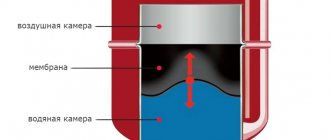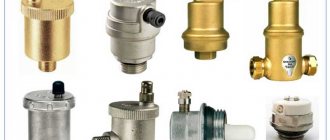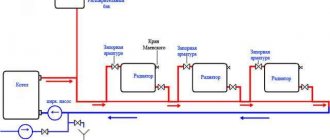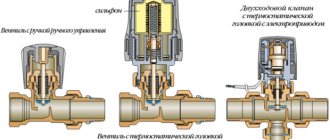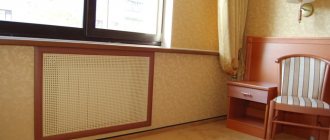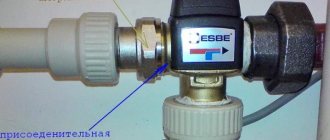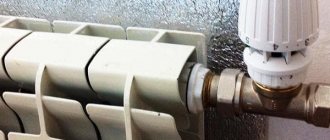Heating radiators have become a part of modern life. Invisible helpers warm our home, making it truly cozy and comfortable to live in. Cast iron, steel, aluminum, made of brass or copper - sooner or later they all take on a less than marketable appearance. In this case, despite some financial and thermal losses, the best option to hide visible flaws would be to purchase a protective screen for the heating radiator. The question immediately arises of what material or design to choose in order to eliminate heat losses as much as possible and not lose money on the price. The editors of Seti.guru, as always, have collected the most interesting ideas for decorating your home.
You can use the battery in this way, or you can come up with an interesting solution using a modern screen for the radiator
Why do you need a screen for a heating radiator?
A bad battery screen will shamelessly and brazenly steal your heat.
And you lose, first of all, heat. We all know how in Soviet times they fought a hot battery by simply covering it with a blanket. This was the first screen for a cast iron battery. The protective screen works on approximately the same principle. If heat loss is not too noticeable in summer, then in winter it can become a problem. That is why, before deciding to choose a screen for a heating radiator, it is very important to calculate the probable heat loss. In this case, it would be useful to study the distribution of heated air in the room where the radiator is installed.
The principle of heat transfer in a radiator battery
The battery's operation is based on the convection mechanism: warm air masses rise upward, and cold air masses go down.
Note! The correct radiator grille should direct warm air upward, thereby blocking the path of cold flows from the window. Grilles on the top panel or directional slits will help ensure such a flow.
Thus, when installing a radiator screen, it is always necessary to leave a gap for the intake of cold air, and ensure its unobstructed exit from above. The radiator's heat transfer will also depend on the width of the gaps and grille holes for the heating battery.
First of all, let's consider situations when installing a screen is necessary:
- If there are children in the house who can easily get burned by too hot radiators.
- Unsightly appearance of the radiator, but quite usable.
- If there are animals in the house that could get hurt by the battery, get stuck there or get burned.
- The radiator is too bulky.
- It is necessary to adjust the flow of warm air in the desired direction.
Existing structures
Decorative grilles for radiators vary in size, shape, design, material and other indicators. Before choosing, you need to determine the purpose of the item. Designers recommend not making it noticeable. It cannot be a key element in the interior; it must be used to support the style.
In stores you can find three types of designs:
- Flat or facade overlays. It is advisable to use them if the radiator is embedded in a niche. The product is in the form of a flat frame with a lathing. The shape of the overlays is square and rectangular. A significant drawback of the design is the difficulty of installation. The facade screen is installed overlapping the wall, trying to ensure that the battery does not protrude beyond its boundaries.
- I often use mounted ones to hide old cast iron batteries, in the form of an accordion. It is difficult to attach them to ordinary bimetallic radiators. The hanging pad is attached to hooks or placed on the outer ribs of the battery.
- Protective box This option is the most difficult to install and manufacture, but buyers often choose it because of practicality.
A video review will help you understand the types of design solutions.
Battery screens: their advantages and disadvantages
With the help of radiator grilles, you can completely hide the radiator from human eyes and make even the most massive structures invisible to others.
In addition, the battery box reduces the risk of injury and burns to both people and animals. And the battery itself receives a protective case, which eliminates possible mechanical damage or chips. In addition, decorative grilles for heating radiators can change for the better the interior that is familiar to the eye.
This battery screen will hide all imperfections and will decorate the room.
If we talk about the disadvantages, these are, first of all, heat loss. However, this “trouble” can be overcome if you choose screen models with a large number of holes or large gaps.
What are radiator grilles made of?
Wood, plastic, tempered glass, aluminum, cast iron and pressed slabs - this is the main list of materials that can be used in the manufacture of decorative screens for heating radiators.
Tree
Wooden grilles for a heating radiator are one of the most expensive screen options. Firstly, it is an environmentally friendly material, and secondly, it does not emit any toxic substances when heated. Typically, such grilles have a special non-flammable coating and are safe for installation in children's rooms and bedrooms.
Thanks to small gaps and good heat dissipation, such radiator screens can perfectly cope with the task of retaining heat on the one hand, and protect your child from burns and bruises, on the other hand. Such products are quite strong and durable. In addition, this material allows you to slightly expand the boundaries of the usual understanding of what a decorative grille for heating radiators should be.
The radiator screen can easily turn into a shelf for books and toys
But such beauty must be cared for carefully and treated with special compounds so that the structure does not “sink” due to excessive drying. There is a large price gap in the cost of such “masterpieces”: slatted variations can cost about 1,000 rubles, designs using natural wood, especially carved variations, can reach up to 6,000-7,000 rubles per piece.
Metal
Aluminum screens have become more durable and, naturally, have maximum heat transfer. Radiator grilles on a metal battery act as an additional heating element.
A special feature of the metal structure is the ability to apply designs to the surface of the screens or paint them, which simplifies the choice of design solutions. Such grilles can be either openwork or with uniform perforation; they can come in the form of an overhead grille or have a solid frame.
Glass
But glass for a decorative grille for a heating radiator is not the most popular option. Despite its versatility (any ornament, photo or image can be applied to this surface), glass is fragile and easily soiled. Glass screens for batteries are not a very good solution for families with small children, because even tempered glass can break if hit by a careless metal toy.
Glass can be frosted, colored, or transparent, with photo printing or sandblasting.
Plastic
This material is less environmentally friendly and has low thermal conductivity. Less durable than glass and wood, which is why multilayer technology for manufacturing such products is used in production. In addition, in case of strong heating, this material releases harmful substances, which is why plastic screens cannot be used in children's institutions.
Plastic screens are most often used to protect batteries from dust.
It is recommended to install such structures in utility rooms, shops, and domestic premises, where heat loss may not be so noticeable. Among the advantages are light weight, corrosion resistance, moisture resistance, and the ability to apply drawings.
MDF and HDF
MDF is a board pressed from wood chips. Quite fragile, but at the same time cheap material. The big disadvantage of panels of this type is chipping and shedding of corners and elements, as well as low moisture resistance.
At first glance, MDF boards cannot be distinguished from solid wood products
A more innovative version of MDF is HDF boards. Actually, these are also shavings, but the pressing process occurs at higher temperatures, the natural component ligin is released from the raw material, which, when heated, turns into organic glue, which binds the fibers into a dense layer.
Perforated HDF boards
Example of a radiator grille made from HDF board
Interesting fact! The density of HDF is from 800 to 1000 kg/m³, and MDF is only up to 800 kg/m³.
This material is more environmentally friendly and durable. This material is currently considered the optimal solution for covering radiators.
Plastic
Polyvinyl chloride having suitable characteristics can be used to make protective screens.
Finished products can be either homogeneous or composite (in addition to PVC, the composition may include metal or rattan). The outer surfaces of plastic gratings can imitate several types of coatings - wood, stone or metallic. It’s worth noting right away that PVC has a low degree of thermal conductivity compared to wood and metal, so plastic grilles cannot provide full heat transfer from batteries. The conclusion is obvious - the use of such products cannot be called economically profitable, since reduced heat transfer always leads to increased heating costs.
However, low efficiency is the main drawback of plastic grilles, but in other respects they are quite good. Thus, PVC products can withstand high temperatures well, have a long service life and are completely safe. In addition, such grilles have very good decorative qualities and can be used to decorate any style. And lastly, the cost of plastic protective grilles and screens is much lower than all analogues.
Types of radiator grilles for radiators
Related article:
Which heating radiators are best for an apartment. In a special publication, we will consider not only the types of devices, the criteria for the right choice, but also manufacturers, models, and useful tips.
Regardless of whether you make a screen for the battery with your own hands or install one purchased in a store, the installation of this accessory occurs according to the same scheme, which depends on the type of mounting: floor-mounted, wall-mounted, mounted.
Let's look at all three of these options. Floor screens for a radiator: most often this is a regular box with legs, which is placed on top of the battery. This design, on the one hand, protects the device well, on the other, has low heat transfer. Especially if it is made of plastic. Therefore, for this type of installation, it is best to choose metal or HDF panels with perforations.
This option is convenient because it does not require labor-intensive wall mounting. It can be easily removed to wash or clean from dust.
Expert opinion
Andrey Pavlenkov
HVAC design engineer (heating, ventilation and air conditioning) ASP North-West LLC
Ask a specialist
“If the apartment is cool, then you cannot use grilles with too small and sparse holes. But if it’s the other way around, these are the models that will suit you. However, in this case, it is better to avoid wooden and plastic options - the former will crack over time, and the latter can emit an unpleasant odor when overheated.”
Wall-mounted ones are the most difficult to install. To install such structures, it is better to invite a specialist, because you will need to violate the integrity of the wall.
However, as practice shows, the heat transfer from such structures “recessed” into the wall is much higher.
Flat and hanging decorative screens for batteries
Mounted radiator variations are the easiest type of radiator grilles to install. Such structures are simply assembled using four screws and placed on an aluminum or bimetallic radiator like a cover.
The main disadvantage is the fairly close contact between the battery and the box, which prevents proper air circulation. In addition, the screen material comes into contact with a hot surface, which does not go unnoticed on wood and plastic.
Grille-box for heating radiator
A casing or box for the battery is the solution when the heating device has completely lost its presentation. Decorative radiator grilles cover the radiator on all sides.
The peculiarity of the design is that with the help of such boxes you can close radiators that are rotating or protruding from under the window sill.
Important! When installing the box, it is necessary to provide access options to valves and drain structures. Typically, for these purposes, screens are provided with a removable end.
HDF, MDF, wood, as well as metal can be used as the main materials for the construction of screen-casings; glass and plastic structures are not suitable for these purposes.
Making your own plasterboard box - step-by-step instructions
You can make a neat plasterboard box for fixing a flat decorative screen yourself .
Table 3. Step-by-step instructions for making a plasterboard box.
| Illustration | Description |
| Step 1. A guide profile for drywall (27 x 28) is used to make slats, the length of which is equal to the parameters of the structure being manufactured. | |
| Step 2. A profile is placed into the guide on one side. | |
| Step 3. Make holes. | |
| Step 4. The frame is assembled, controlling its geometric parameters using a building level. | |
| Step 5. Fix the drywall panels. | |
| Step 6. A hole is cut in the drywall and a decorative screen is installed. |
After installation, the box is painted in the desired color to match the interior of the room.
In addition, we recommend you our article on the topic - Wooden balusters, where we looked at their types, as well as step-by-step instructions for making them yourself.
Features of fastening decorative radiator grilles
Attaching decorative screens, as we have already said, should provide easy and quick access to communications and equipment. In this case, the battery is easier to clean and rinse if necessary. The denser and thicker the box, the less dust and dirt gets inside. Attached and mounted structures are more convenient for emergency “opening”.
Less convenient are those built into the wall. The fact is that such structures are often remote from the radiator itself. In this case, small hidden windows with locking mounts can solve the access problem.
Such structures recessed into the wall can serve as an excellent hiding place for a “stash.”
How to choose a model taking into account the rules of heating engineering
In order not to make a mistake when choosing or manufacturing a grille or screen, you need to take into account some points. Especially for its readers, the editors of Seti.guru have collected the best ideas for preserving heat using decorative radiator grilles:
- To make the screen better “hold” heat and heat up, the back of the battery can be painted a dark color.
- The space behind the radiator battery can be covered with a special reflective film, which will provide stronger heating.
Battery with reflective screen made of isolon - It is better to choose a box or radiator grille with perforations on the top panel. Metal battery with perforation
- The distance between the slats in the front panel directly affects the percentage of heat transfer; the larger they are, the more efficient the heating is.
- It is better to choose designs equipped with an aerodynamic visor. It is very convenient if the radiator is “hiding” under the windowsill. In this case, the metal canopy will prevent air from accumulating directly above the battery and will redirect it into the room.
- You can improve the radiator grille with a homemade injector. If you install two directional blades correctly, they will collect a warm air flow and direct it towards the room.
This is what an ideal decorative radiator grille should look like.
The ideal device for a proper radiator battery with a screen
Stages of work
- Cut the workpieces to size. When measuring the dimensions of the battery, you need to add at least 3-8 cm on each side for air exchange.
- The joints of the parts must be processed at an angle of 45 degrees for a tight fit.
- Cut the sheet mesh according to the specified parameters.
- Connect the facade and sides with a metal mesh. You can attach it using a construction stapler from the wrong side of the frame. Small nails are also suitable for joining.
- Assemble the box using corners and screws.
- Install a metal sheet at the back of the radiator to increase heat transfer. Instead of a sheet, cardboard covered with foil can be used.
- Attach the legs to the bottom of the box. Adjustable models allow for more precise installation.
- Place the box to the battery. Attach the sides to the wall using metal corners and screws. Fasteners should be hidden, like hanging shelves. You don’t have to fasten the structure, as the legs provide sufficient stability.
- Fiberboard parts are painted, covered with wallpaper to match the walls or using self-adhesive.
The metal mesh can be replaced with a perforated MDF panel, plywood with a pattern cut out, or wicker rattan.
The nuances of making a heating screen with your own hands
Before you create a screen for a heating radiator with your own hands, you need to decide on the material. Typically, home craftsmen opt for metal and wooden structures. The simplest solution is to use ready-made circuits. The main thing for a beginner is not to forget to provide slots or removable elements for access to shut-off valves and the Mayevsky tap. For approximate planning of material consumption, the following drawing diagram is suitable.
Drawing diagram of screen assembly for radiator battery
Learn more about how to assemble a decorative screen in this video:
Today we decided to be original and present a rather unexpected design option for a decorative screen for a battery. So, let's begin. First of all, let's prepare the necessary materials. We will need: a large photo frame (it should be slightly wider than the size of the battery), burlap or any fabric with a dense structure. It is important that the piece of material is twice the size of the frame. A ball of thread, buttons, hooks, ribbons.
| Image | Action |
| We cut the burlap into two rectangles, which are slightly larger than the edges of the frame (about 2-3 cm). | |
| In one of the pieces we cut a hole to the size of the desired “heat catcher”. We make cuts in the fabric of the same length, like sun rays, towards the edges of the frame. | |
| We bend them and fasten them, just like trouser straps (holes where the belt is threaded). | |
| We thread the thread into the holes formed and stretch the fabric. | |
| We weave our “web” according to the proposed scheme. | |
| As a result, we got this wicker center. We attach a thread with pre-strung beads to it. | |
| We hang it on hooks previously screwed to the window sill. The second part of the material is used as a damper. |
Dimensions
The dimensions of the finished gratings are calculated based on the dimensions of a standard central heating battery, namely:
- 30*60 mm;
- 60*60 mm;
- 90*60 mm;
- 120*60 mm.
Products in these sizes can be purchased ready-made. If the radiator parameters do not correspond to them, the decorative grille will have to be made to order; to do this, you need to take the dimensions of the radiator and determine the required color in advance.
The price depends not only on its size and materials. A custom-made product costs more than the classic version. It is interesting to note that wooden overlays are rarely seen ready-made in stores. Manufacturers claim that the demand for them is small and the price is high, so they are rarely ordered as samples.
Decorative grilles for heating radiators: photo ideas
However, discarding all the technical aspects, it is important not to forget about the decorative component. The editors of Seti.guru have prepared a photo selection of radiator screens especially for their readers, the price of which can be quite affordable.
If you have any questions for the author of the article, leave your comments below.

